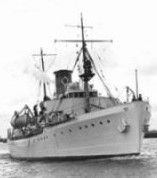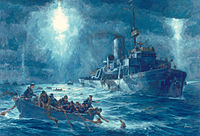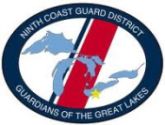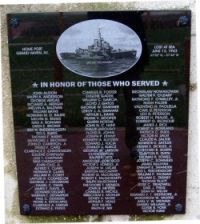
U.S.C.G.C. Escanaba (WPG-77)
(1932 - 1943)
"If terror is the tempest's voice, or freedom's enemy,
It's evil broke by courage with a cutter on the seas."
("Cutter on the Waves"; CD - "Storm")
© 2014 Dan Hall
On April 18, 1930, following a string of marine disasters on Lake Michigan, an act of Congress authorized the building of a larger and more powerful cutter that would be able to better assist the growing tonnage on the Great Lakes. An appropriation of $650,000 was made for its construction and equipment; the contract being given to Defoe Boat & Motor Works of Bay City, Michigan on November 10th. The work was completed on November 14, 1932 and the new cutter was christened ESCANABA (WPG-77). Her 1,500 horsepower made her one of the most powerful vessels of her type on the lakes while her heavily plated stem was sheered to allow her to plow through the ice more easily. She was also equipped with every sort of modern equipment needed for rescue operations during extreme weather conditions. The Escanaba's permanent station would be Grand Haven, Michigan, much to the disappointment of Milwaukee officials who had petitioned the coast guard to keep her at Jones island. Arriving at Grand Haven covered with ice and snow in the middle of a December blizzard she was welcomed with open arms, and the high school band, by the city that would come to love her, affectionately calling her "Esky".
Through the next nine years the Escanaba's silver-white bow became a familiar and most welcome sight as she went about her duties around the lakes where records of her battles with the gales, ice and deadly cold during rescue operations would become legion. In November, 1934, the Escanaba fought her way from Grand Haven to Muskegon in a 60-mile gale to train her high intensity searchlights on the wreck of the old whaleback tanker Henry Cort, smashed against the breakwater, enabling those ashore to conduct rescue operations. In March, 1936, almost the entire village of Fairport, on the tip of Michigan's Garden Peninsula, turned out to watch the 165-foot cutter Escanaba smash through the ice field that had halted all fishing operations there since the middle of January. Whether smashing through ice fields, rescuing million dollar lake vessels or plucking fishermen from the impending jaws of death, her watchful gaze provided protection from shore-to-shore during her duty on our inland seas. In October, 1940, the cutter was ordered to Manitowoc to prepare her for upcoming ice-breaking operations. She was still tethered there in November, 1940, when the Armistice Day storm ripped across Lake Michigan leaving 60 dead in its wake and another 17 waiting 36 hours for rescue aboard the wrecked pulpwood carrier Novadoc; a decision that brought the Coast Guard under harsh criticism for causing the Escanaba to be layed up during the most dangerous month for navigation on the lakes.
Early in 1941 Escanaba was again sent to Manitowoc. On this trip she would be converted to a ship of war. In February she spent 33 hours fighting a savage gale while crossing from Grand Haven to Chicago where she would proudly show off her new 50-inch caliber anti-aircraft guns, depth charge "Y" guns and mine tracks before departing her home waters to carry out her military duty on the Atlantic ocean, her white hull now coated with camoflage "warpaint". From her new home port, Boston, she would perfom escort duty as well as search and rescue operations as part of the Greenland Patrol. On June 15, 1942, while on escort duty, Escanaba made depth charge attacks on two enemy submarines. Although no sinkings were officially confirmed she was credited with the sinking of both in a single day. Later, the same day, the cutter rescued 22 crewmen of the USS Cherokee which had been torpedoed and sunk.
 In the pre-dawn hours of February 3, 1943, Escanaba was present to participate
in the rescue of the crew of the Army transport Dorchester which had been struck by a
German torpedo. Over the side, donned in survival suits, went Richard A. Arrighi (Ensign),
Forrest O. Rednour (Cook 2d Class), and Warren T. Deyampert (Steward's Mate 3d Class) to pluck one hundred thirty-three of Dorchester's crew from
the icy waters of the north Atlantic.
These rescue swimmers tied lines around those who were too injured, paralyzed by the cold, or weakened by shock to help
themselves and they were dragged aboard the Escanaba. Even those who appeared to
be dead were tied in this way with only 12 of the 50 "dead" actually found to be
deceased. This was the first time that rescue swimmers or survival suits had been
used.
In the pre-dawn hours of February 3, 1943, Escanaba was present to participate
in the rescue of the crew of the Army transport Dorchester which had been struck by a
German torpedo. Over the side, donned in survival suits, went Richard A. Arrighi (Ensign),
Forrest O. Rednour (Cook 2d Class), and Warren T. Deyampert (Steward's Mate 3d Class) to pluck one hundred thirty-three of Dorchester's crew from
the icy waters of the north Atlantic.
These rescue swimmers tied lines around those who were too injured, paralyzed by the cold, or weakened by shock to help
themselves and they were dragged aboard the Escanaba. Even those who appeared to
be dead were tied in this way with only 12 of the 50 "dead" actually found to be
deceased. This was the first time that rescue swimmers or survival suits had been
used.
Barely three months later, at 5:10 a.m. on June 10th, Escanaba and 101 of her crew would be lost when the cutter was torn by a tremendous explosion amidships while on convoy duty, sinking so quickly that no distress signal could be sent. Only one body was recovered and just two of her crew survived; neither of them knowing exactly what had caused the sudden explosion. Although it was intially thought Escanaba had been the target of an enemy torpedo there was never a definate explanation for the explosion which could have been caused by an internal accident or, more likely, by striking a floating mine.
The city of Grand Haven, Michigan, which proudly thought of the Escanaba as "theirs" even in her absence, was shaken to the core when the navy announced her loss. On August 4th over 6,000 people gathered gathered to observe Coast Guard Day and hold memorial for their lost "Esky" and her crew. This memorial has become an annual tradition and is included each year as part of the Grand Haven Coast Guard Festival. In the wake of the Escanaba's loss the citizens of her home port community, by holding annual tributes, managed to raise over one million dollars in bonds for the construction of a new cutter that would bear the name Escanaba in her honor. The Escanaba's mast had been recovered and erected in Kelly Memorial Park which, in 1949, was renamed Escanaba Memorial Park.
"Wherever they are needed it's the duty of the brave,
and many lives protected by a cutter on the waves."
("Cutter on the Waves"; CD - "Storm")
© 2014 Dan Hall






